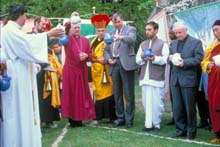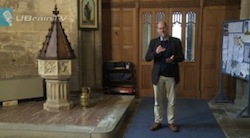|
|
|
|
 |
|
ARC's Sacred Land project
 |
 |
 |
The Archbishop of Canterbury, Dr George Carey, launches the Sacred Land project at St Mary's Well, Willesden, in 1997 |
ARC's Secretary-General Martin Palmer has written a guidebook to Sacred Land which was published in March 2012. The book shows how to decode every aspect of our landscape including the medieval map hidden in a modern city. It is the latest publication that has emerged as a result of the Sacred Land Project. Link to www.sacredlandproject.org for more details.
Background to the Sacred Land Project
The Sacred Land Project was launched by the Archbishop of Canterbury in April 1997 with the aim of reviving and creating sacred sites in Britain and overseas. It
is about reminding people that the landscape where they live can be as sacred as any holy land. Read the Sacred Land Report here.
 |
| In the Middle Ages every church had its own holy sepulchre – model of Christ’s tomb – to remind people that even the most ordinary village was a place where Christ had lived, died and risen again – and was therefore sacred. |
|
 |
 |
In Britain alone it involved Buddhist, Christian, Hindu, Jewish, Muslim and secular communities in creating and reviving inner-city and community gardens; conserving and celebrating holy wells; rediscovering and renewing pilgrimage trails; protecting trees and woodlands; regenerating community meeting places and their eco-systems; and celebrating sacred places with works of art and poems.
Key to Sacred Land's success was its mission to work with groups, not individuals, on projects that are open to the public. It was WWF’s major religious undertaking in Britain and has the backing of the principal churches, conservation and environmental organisations, and the major faiths practised in Britain.
Sacred Land has led to hundreds of projects run by faith groups along this model - some of which we know about, many of which we will never hear about.
Sacred Land after 2007: the Sacred Sites and Faith-Protected Environments Programmes
For ARC the project has moved to become a Sacred Sites Programme, with the intention of making the term "sacred site" an internationally recognised term, conferring protection by national governments and others.
The issue of protection of sacred sites reveals a fascinating difference in theological and therefore psychological understandings of sacred sites. In the Abrahamic traditions, for example, protecting nature is a natural outcome of the notion of people’s role before God as guardians, stewards or priests of creation. However for other traditions, notably Hinduism and Shintoism, it is we who should recognise that we are protected by nature.
This led to an agreement at the Faiths and Forests meeting at Visby in August 2007 that ARC should undertake work to help each major tradition to define its own theology of sacred sites, and in particular to outline their position on respecting and protecting those sites that are either sacred to other traditions and/or which they share with other traditions.
ARC is now in active discussion to develop this idea into a formal programme incorporating alongside this the commitments made with WWF International at the World Parks Congress in 2003 to have sacred sites agreed as a term of international protection and the development of a sacred sites programme with UNDP.
Beyond Belief
In 2006 WWF-International and ARC published a ground-breaking document titled Beyond Belief which explored the role that faith can play in the protection of sacred forests, mountains, rivers, lakes, seas and deserts. Link
here for more details, including a full download of the document.
The ancient meadows of Gotland
Meanwhile, new sacred sites are being declared as protected or cared for. For example, during the meeting on Faiths and Forests at Visby in August 2007 the Church of Sweden declared that the endangered meadows of Gotland, of which the Church owns the majority, would now be classified as Church of Sweden Protected Environments.
Sacred sites in Mongolia
In 2002, the monks of the newly revived Gandan Monastery helped by ARC, WWF Mongolia and the World Bank, published a collection of ancient sutras, or sacred texts, entitled Sacred Sites in Mongolia. The texts describe the sacred geography and rituals of 80 sacred sites whose use had been suppressed under communism. Link to our Asian Buddhist Network section for more details about this programme, which is largely financed by the World Bank.
The Forests of Lebanon
The Maronite Church – representing Lebanon’s most popular form of Christianity – owns a large proportion of the Harissa forest and in 2000 the Church made the unprecedented move of issuing a public pledge to preserve its forest. With the support of local conservation group AFDC (Association of Forest Development and Conservation) and ARC, the Patriarch pledged to make the Harissa Forest the world’s first “Maronite Protected Environment”. Link here for more details.
 |
 |
 |
Martin Palmer explaining the Sacred Land technique in the UBrain TV film |
Download the Sacred Land Information Pack from our Downloads section
In partnership with UBrain TV Martin Palmer, ARC Secretary General, made a short video film in March 2012 explaining the Sacred Land technique and using one of his own local churches as an example. Use the following links to see part 1 and part 2 of this film.
Statement from the traditional custodians of African sacred sites
This is not an ARC project but we were very inspired to see this statement by communities that are custodians of traditional sacred sites in four African countries - Ethiopia, Kenya, South Africa and Uganda. It was the result of a meeting organised by the African Biodiversity Network in April 2012 to bring together the custodians to look at how better to protect these sacred sites.
In their declaration, the custodians say "future of our children and the children of all the species of Earth are threatened. When this generation of elders dies, we will lose the memory of how to live respectfully on our planet, if we do not learn from them."
They have compiled 14 'common customary laws of sacred sites'. You can read them here.
|
 |
|
|
|
|
|
 |
Sacred Gardens
Sacred gardens are an ancient tradition in every major culture |
 |
Pilgrimage trails and shrines
The Sacred Land project not only celebrates the past, it also makes sure there will be pilgrimage routes and places for people to visit well into the future |
 |
Projects overview
A complete listing of all current ARC projects |
 |
 |
|
|

